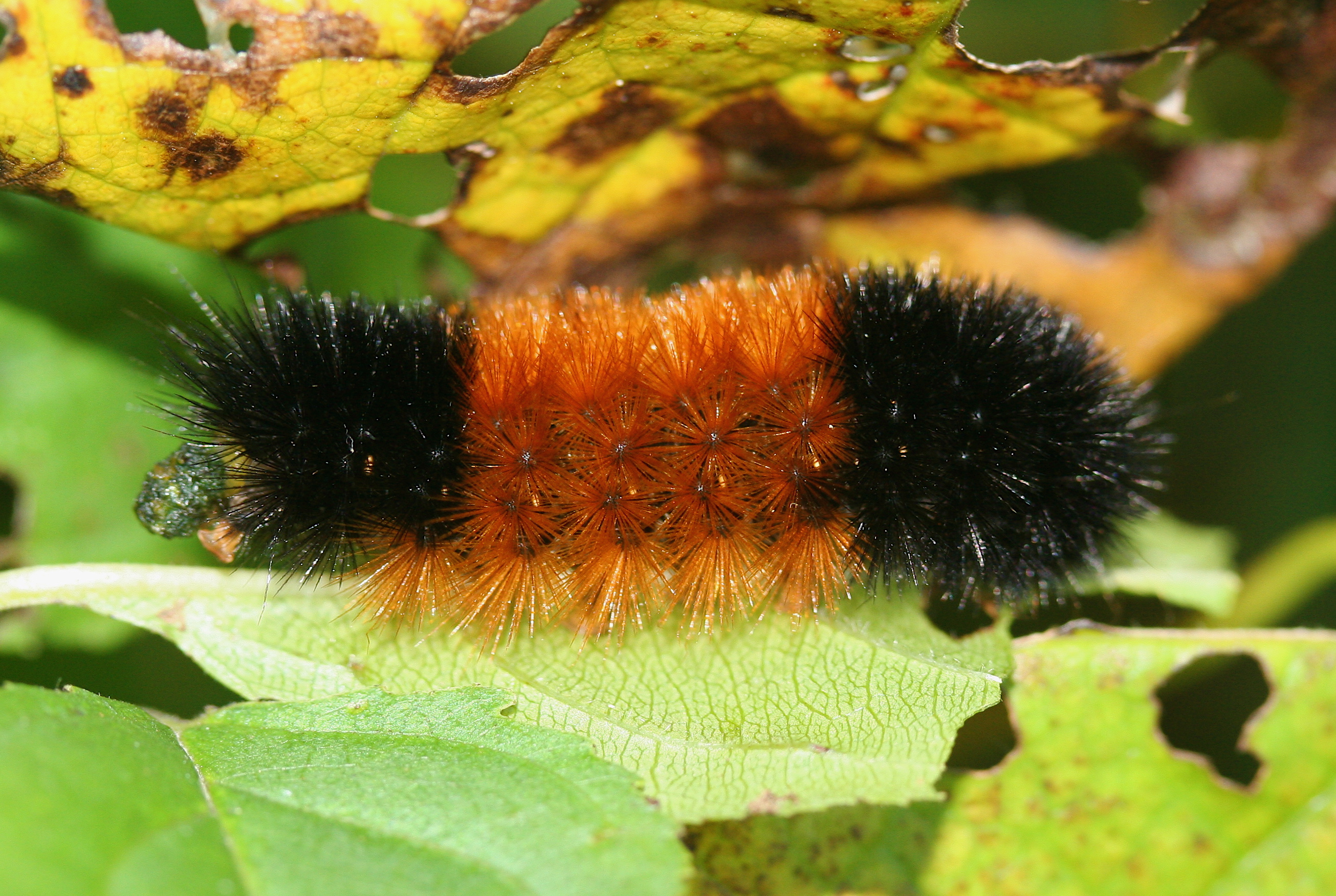On a bright Indian summer day, we took our tandem bicycle to a nearby rail trail for a 20-mile bike ride. The trees had begun to turn, and the combines were out in the fields harvesting the corn. Along the trail we saw squirrels on personal business, a snake basking in the sun, a confused grasshopper which was wandering around on the path, milkweed with their pods burst open and shining with silver threads, and a woolly bear caterpillar.
These caterpillars were out and about, enjoying the sun or looking for a place to overwinter, unaware that they are held to a high standard of performance. They are expected to predict the severity of the winter. They do this, according to the old sayings, by the relative amounts of black and brown on their cylindrical bodies.
Bryan caught one for me as it wended its way across the bike path. It sat on my palm trying to get its bearings, and then, like a slinky in reverse, began to wriggle and stretch to climb my fingers looking for the world it knows of ground and leaves and twigs. The springy bristles that covered it made it feel like a soft bottlebrush. It climbed with its little legs and aft appendages, but it never curled up into a ball when I touched it. After becoming acquainted with the little fellow for a few minutes, we released it back into its natural habitat so it could go about its business.
The woolly bear caterpillar looks a bit like a fuzzy, two-inch-long Tootsie Roll with little legs. It is reddish-brown in the middle and black on either end. Like other caterpillars, it has little bristles that stick out all over its tubular body. Its body has 13 segments, and the saying goes that if the woolly bear has a wide band of brown in the middle, the winter will be mild. The one we caught had a wide band. Good news for the winter! If it has a narrow band of brown, winter will be long and harsh, and if the front band of black is wider than the rear band, the winter will start out hard but will ease up by the end. Scientists suggest that the variability in their bands has more to do with how plentiful food was during the past summer and how many times they’ve molted. Still, maybe the caterpillars know more than the scientists?
The caterpillar has a black head with little eyes and short antennae and a mouth. It has three pairs of true legs, each ending in a little claw, behind the head. Four more pairs of protrusions with little hooks on them attach farther back on the abdomen. These little hooks help the caterpillar hang onto leaves. Because it can’t see very well, the caterpillar has to stretch out its front body and search around with its antennae to figure out what’s ahead of it and which way to move. If it is disturbed, it will curl up into a prickly little ball and hopefully discourage a bird from snacking on it.
Another supposed predictor is the thickness of their bristly hairs. It is said that if they have a heavy coat, the winter will be hard. The woolly bear doesn’t need a coat, though. Unlike most living things, it can freeze solid, or almost solid, and thaw out alive in the spring. It does this freezing routine by first finding a suitable sheltered place to hibernate. Then, with the help of its bristles, which aren’t actually for warmth but rather help the caterpillar control how it freezes, it allows itself to freeze bit by bit. It produces a natural antifreeze that keeps the centers of its cells from freezing. It can actually survive in temperatures way below zero. In the spring, when the weather warms up enough, it thaws itself out and eats for a few days. Then it spins itself an oval, dark-colored cocoon and pupates, transforming itself into an adult Isabella tiger moth (Pyrrharctia Isabella).

Isabella Tiger Moth photo by Steve Jurvetson
This tiger moth has a wing span of one and a half to two inches. Its wings are orange-yellow without distinct markings. It does have three rows of black dots on its abdomen that are characteristic of the Isabella. These moths operate at night. They don’t feed, though. They only mate, lay eggs on leaves, and die. In a couple of weeks, the eggs hatch into little caterpillars which grow and molt about six times. This spring generation chows down on spring plants until they’re ready to turn into an adult. The caterpillars of this spring generation seem to know they don’t have to do the winter freezing thing. They just go about their pupating and by mid summer another generation has emerged as adults, mated and deposited its eggs. The fall generation of the caterpillars hatch and get busy eating leaves and molting until frost when they curl up and freeze for the winter and the cycle repeats.
So, on a warm autumn day like this one, they’ve come off their plants and are on the ground wandering around, looking for a nice cozy place to curl up and freeze.
And what are they saying about the winter? Let’s check!
Featured photo by: IronChris
